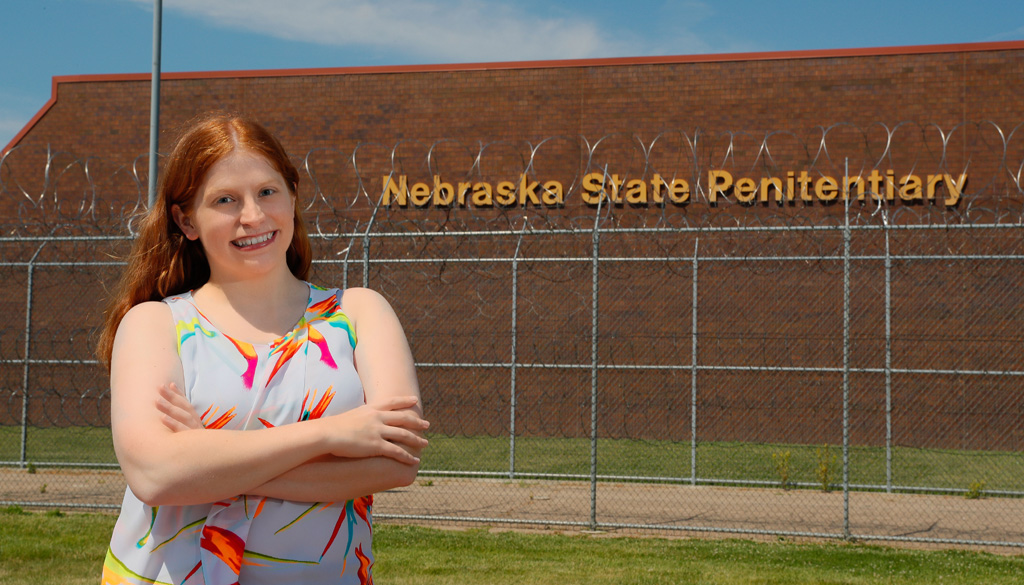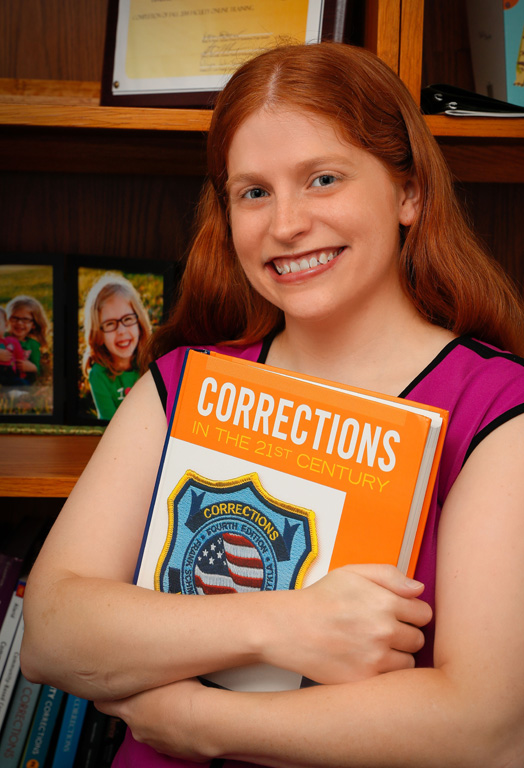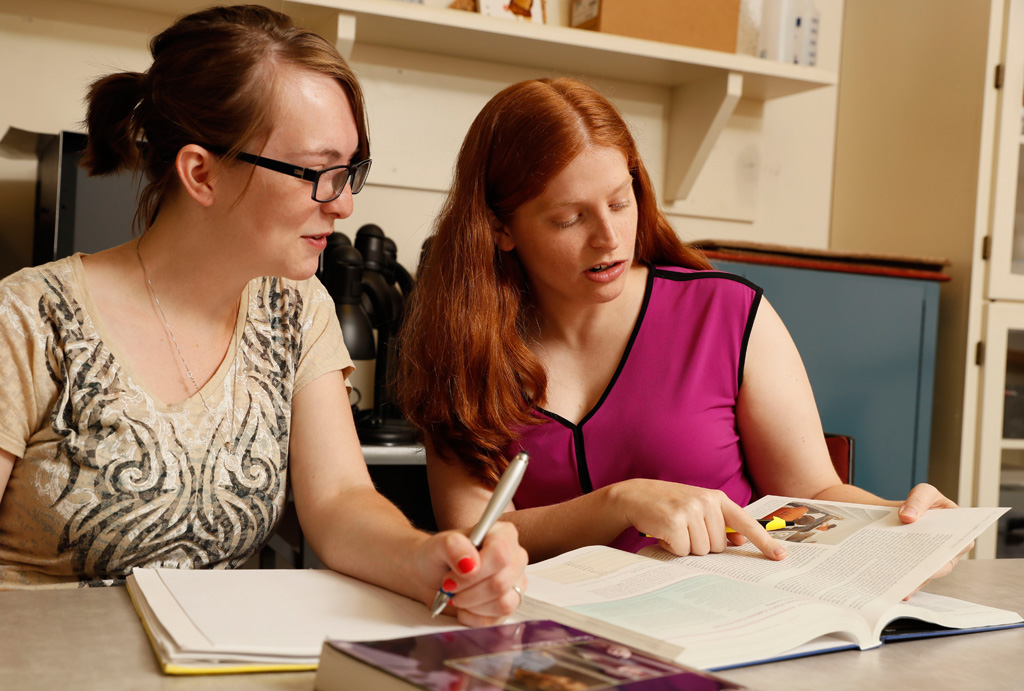 By TODD GOTTULA
By TODD GOTTULA
UNK Communications
She spends her time in small, nondescript rooms.
Where white – gray if you’re lucky – is the color of choice. And the air is different inside.
This place, with its cement floors, protective glass and stainless steel in every direction, is where Timbre Wulf-Ludden’s research takes her.
Inside prison walls across the Midwest. In front of hardened criminals. Analyzing a social system and prison culture that few on the outside have experienced or understand.
Where everything is different.
“This is where I am comfortable,” says the University of Nebraska at Kearney assistant professor of criminal justice. “This is when I’m at my best and having the most fun. I love doing interviews, sitting down with prison inmates in front of me, asking questions and chatting about their lives.”
As a researcher of institutional corrections, Wulf-Ludden spends her time conducting one-on-one interviews and establishing rapport with men, women and juveniles with years in the system behind them. And for some, years of incarceration ahead of them.
“It’s a different world,” she says.
A world of many violent people who will fight you for no reason.
A world that motivates her research, which includes juvenile justice, prison violence and interactions among inmates. Much of her research focuses on female offenders. Her work also examines re-entry challenges for adult male offenders, and the importance of race and gender in media depictions of offenders.
Juvenile justice.
It’s a hot-button issue across the United States, where more than $5.7 billion is spent annually to detain youth. And it’s an especially-charged issue at the Youth Rehabilitation and Treatment Center in Kearney.
Located just west of UNK, YRTC is under examination – locally and statewide – following a string of assaults and escapes.
Wulf-Ludden’s research on youthful offenders and juvenile justice confirms that detaining juveniles for relatively low-level offenses is both ineffective and detrimental. Her 2013 article “Assessing Youth Early in the Juvenile Justice System” found that too much involvement in the juvenile justice system often leads to increases in violent behavior and subsequent law violations.
“When juveniles are detained for low-level offenses, detention does not have a deterrent effect. Instead, it often increases the chance of relapsing into criminal behavior,” Wulf-Ludden said.
Detaining low-risk youthful offenders results in a variety of negative consequences, including reinforcement of violent attitudes caused by association with other high-risk youth, mental health concerns and sexual health issues, she explains.
Nearly 100,000 youth are confined in juvenile jails, prisons, boot camps and other residential facilities in the U.S.
To test the effect of system involvement, Wulf-Ludden examined youth enrolled in two early intervention programs: Juvenile Diversion, which involves formal processing and services; and Early Assessment, a process designed to screen low-risk youth out of system involvement.
Her findings indicate that, 24 months after program completion, Early Assessment participants were significantly less likely to have a new law violation compared to youth who participated in Juvenile Diversion.
“Less contact in the system is good. Unnecessary court involvement contributes to worse outcomes in low-risk juveniles,” Wulf-Ludden said. “You’re not doing them any favors by cracking down super hard. Trying to scare them straight does more harm than good.”
Roughly 40 percent of all detained youth are held for nonviolent offenses, making the U.S. a country that treats adolescent offenders more harshly than almost any other industrialized nation, said Wulf-Ludden.
“Unnecessary detention is not an effective use of resources. It is mostly ineffective and costly,” said Wulf-Ludden.
Why then, do we rely on juvenile detention as our primary intervention for juvenile crime in the United States?
“So often it becomes an emotional decision. The general public doesn’t like the idea of taking it easy on criminals, whether it’s a kid or not. Lesser punishment doesn’t always sit well with people,” Wulf-Ludden explained. “An emotional response isn’t the best response to addressing the problems that brought a kid into contact with law enforcement. We should base our responses on the research out there, a kid’s background and what imprisonment does or doesn’t do.”
The difficulty is determining when involvement is unnecessary and when it is necessary, said Wulf-Ludden.
“We need to focus on individualized treatment and address that specific kid’s needs. However, we need to be careful.
“If we have a kid who is a violent sociopath, who is not going to be helped by programming, they do need to be locked up. But not every juvenile fits that description.”
Timbre admits she “stumbled” into her career in criminal justice and academia.
There was no law enforcement background or interest in her family. Her dad, Gary, was a journalist, reporting agriculture news for KZ100 FM and other radio stations in central Nebraska. He also worked for Dow Jones, writing farm, ranch and market stories. Her mother, Earlene, works at the hometown grocery store in Central City.
The first time she showed interest in becoming a corrections officer, her grandpa Kenny warned her. “Grandpa said, ‘If you go into corrections, I’ll correct your ass,’” she said, laughing. “He didn’t like the idea of me being in a prison. If he was still alive today, he probably wouldn’t be a fan of my research.”
In high school, Wulf-Ludden was involved in speech and drama at Central City High School, where her speech teacher encouraged her to look at a career as a lawyer.
“She saw I was good at speech and encouraged me to take some law classes in college.”
Timbre’s older sister, Kellie, also pushed her toward criminal justice.
“She helped set up my freshman-year schedule at UNL, selecting some political science and criminal justice courses to see what I would like.”
It didn’t take long for Wulf-Ludden to develop a strong interest in criminal justice. While taking Criminal Justice 101 at the University of Nebraska-Lincoln, she was drawn in by her professor, Chris Eskridge, and his stories.
“That class was exciting and fascinating. I was hooked right away, and I decided to take more criminal justice classes and just kept going in that direction,” Wulf-Ludden recalled. “I kept falling deeper into it. I truly just lucked into a profession that I really enjoy.”
Wulf-Ludden, 30, worked as a graduate assistant at University of Nebraska at Omaha from 2008-13, received her Ph.D at UNO in 2013 and came to UNK in 2014 after working as an instructor earlier that year at UNO and UNL.
She calls UNK the “perfect fit” for her classroom and research interests.
“The support here is incredible. UNK wants you to do research and helps you accomplish your research goals,” she said. “There’s a nice balance here between classroom and research. I’ve never wanted to go to a Research I college that focuses more on research than students.
“I’ve always felt that institutions of higher education should focus on education, and that’s what UNK is about. Research is important here, but it isn’t more important than students.” In her UNK classroom, and when mentoring students conducting their first research projects, Wulf-Ludden does her best to draw on her own experiences as a young researcher.
“You have to be stubborn and can’t be willing to take no for an answer. You get told no a lot and have to come at things from different angles,” she said of the advice she gives students. “You can’t get pushed around. I’ve learned to stand up for myself and say, ‘This is what I want’ and go get it for myself.
“If you want something, you have to stick with it and keep trying and working and improving until you get a yes. You can’t let people bully you and boss you around if you want to do research that you think is meaningful and important.”
Wulf-Ludden repeatedly says she is “fortunate” to work on the UNK campus, which is just 65 miles from her hometown of Central City.
“I always saw myself working in the University of Nebraska system. Kearney is close to home, and I feel comfortable here. I know the type of students who attend here. They are kids who are excited about their studies, who talk and participate in class and are into it.
“I really love the atmosphere at UNK. It’s an environment I’m comfortable in, where I am surrounded by people like me and feel like I belong.”
Violence is the accepted tool to solve problems in prison, and female inmates are often motivated by that violence.
“At times, it’s really a social event. Relationship violence, the drama – it’s accepted as a fact of life and part of women’s prison culture,” said Wulf-Ludden. “Women’s prisons have become more violent than they were in the past. For many women with a history of victimization, they’ve learned that violence is a useful problem-solving tool.”
Wulf-Ludden’s 2015 article “Partner Violence in a Women’s Prison: The Social Consequences of Girlfriend Fights” focuses on relationships among women in prison and social consequences of girlfriend fights.
Personal relationships in women’s prisons are very important, and women go to great lengths to maintain social ties while incarcerated, Wulf-Ludden said. Women create pseudo-families and find girlfriends in prison, and they rely on those personal friendships to keep them out of trouble in prison.
“Inmates often claim that they develop deep, meaningful relationships while incarcerated and describe the relationships as loving and emotionally satisfying,” Wulf-Ludden says in her research.
“Over and over inmates told us that they’d have a lot more fights if not for the strong friendships and inmates helping keep them out of violent situations,” added Wulf-Ludden. “Having a friend and positive interactions helps inmates get through their time.”
However, female inmates also identified their “girlfriends” as the leading cause of verbal conflict and physical violence in prison, as they often involve other inmates in their personal problems.
“Women fight, yell and threaten their partners, or inmates seen as threats to their relationships,” Wulf-Ludden said. “There is a very interesting dichotomy. For women, having a friend or confidant leads to positive things women do for each other. But when women have actual girlfriends and romantic relationships, those often become poisonous and create a lot of the violence and spectacle.”
The majority of incarcerated women in the United States suffer from histories of sexual and physical abuse, said Wulf-Ludden, and many model their prison relationships after their non-prison relationships. They simply continue the cycle of violence and dysfunction while incarcerated.
“It’s their way of life. A huge chunk of incarcerated women have histories of victimization, where they have been victims of violent, abusive and really toxic relationships on the outside. That translates to their romantic relationships on the inside. That’s the normal in their lives, what they’ve experienced.”
Additional research by Wulf-Ludden also zeroes in on prison violence, interpersonal relationships and inmate friendships. Her 2013 article “Interpersonal Relationships Among Inmates and Prison Violence” – co-authored with Metro State University Assistant Professor of Criminal Justice Rebecca Trammell – explored the benefits of having a friend in prison for males and females.
Wulf-Ludden’s work – which included 383 inmate interviews at five adult prisons in the Midwest – focused on whether the presence of friendships in prison affected prison violence.
She revealed that both male and female inmates described a variety of benefits resulting from befriending a fellow inmate, from providing advice and companionship to avoiding trouble and encouraging self-improvement.
The “real straight talk” is that positive relationships keep inmates out of trouble, make prisons safer and improve inmate attitudes, said Wulf-Ludden.
Encouraging positive social skills and learning what it means to have a healthy relationship is an important step, she added.
“These are people primarily coming from unstable backgrounds, and we can’t expect them to magically know the difference between good and bad social skills,” said Wulf-Ludden. “If they’ve been taught negative social skills, somebody has to make the effort to say ‘Hey, here’s some new tools to improve your communications and relationship skills.’”
Wulf-Ludden said the lack of domestic violence programs nationally among the female prison population is appalling.
“Victims of partner violence are often punished along with their abusers, and this only further ingrains the victim’s cycle of learned helplessness. Without addressing the issue of partner violence within the correctional arena, administrators and staff are perpetuating the violence that negatively affects the victim’s safety.”
Her research argues that a two-fold approach should be used to stop the cycle of violence.
- Prison officials must learn to identify and intervene when partner violence is present. They must also offer educational treatment programs to help incarcerated women address and understand the serious consequences of abuse.
- Policies should be put into place that allow victims to openly discuss problems in their relationships in order to find the help they need.
“Prison officials need to intervene and focus on the community as a whole to stop this cycle of violence, which means addressing partner violence as a social problem with viable solutions. Punishment alone does little to stop the cycle of violence,” she said.
“Prison administrators do a huge disservice to victims by teaching them that their cries for help are a waste of time. We can do a better job.”
Similar to her takeaways in other research, Wulf-Ludden found that prison administrators can reduce violence by establishing programming that emphasizes non-violent conflict resolution strategies.
In fact, many men in her study expressed their desire for non-violent options for conflict resolution such as communication groups, intervention, mediation and treatment programs.
“They don’t want to fight. They want alternatives that don’t include violence and to be shown other ways to solve conflict,” Wulf-Ludden said. “If we want them to return to the community and be a successful, nonviolent member of society, we need to help them reprogram and realize violence isn’t the answer.
“When inmates feel like they are respected and treated with dignity by staff and inmates, they are willing to be civil,” Wulf-Ludden added. “Respect is a huge thing for inmates. If they feel disrespected, their attitudes are, ‘Why should I respect anybody around me.’ If you can foster a respectful environment, then typically there is less aggression.”
The solutions sound easy, but Wulf-Ludden admits they are not.
“As much as we’d like it to be, crime isn’t nice and neat, and black and white. There are human beings on both sides of crime, and others who love them. We have to be compassionate at times.
“Accountability is certainly important, but I want people to take away that we need to look at the whole picture, the whole context, before we react. Gut reactions don’t do any good in criminal justice. That’s not the best response. It might feel good at the moment, but it’s typically not beneficial for either side.”
-30-
 TIMBRE WULF-LUDDEN
TIMBRE WULF-LUDDEN
Title: Assistant professor, Department of Criminal Justice
College: Natural and Social Sciences
Education: Ph.D., University of Nebraska at Omaha, 2013; Master of Arts, University of Nebraska at Omaha, 2010; Bachelor of Science, University of Nebraska-Lincoln/Omaha, 2008.
Years at UNK: 2
Career: Graduate assistant, University of Nebraska at Omaha, 2008-13; Instructor, UNO and University of Nebraska-Lincoln, 2014.
Family: Husband, Chase Ludden.
Hobbies/Interests: Kansas City Royals baseball, spending time with nieces, volunteering at pet shelter, cross-stitching, sewing.
Areas of research/specialization: Institutional corrections, prison violence, female inmates, importance of race and gender in media depictions of offenders, re-entry challenges for adult male offenders, juvenile justice and youthful offenders.
Courses taught: Introduction to Criminal Justice; The Juvenile Justice System’s Theories of Crime and Criminal Law; Corrections, Women and Crime; Community Corrections and Special Topics: Violence.
Recent Published Articles:
• “Pseudo-families, Misconduct and the Utility of General Strain Theory in a Women’s Prison,” Women & Criminal Justice online, 2015.
• “Partner Violence in a Women’s Prison: The Social Consequences of Girlfriend Fights,” Women & Criminal Justice, 2015.
• “The Saved and the Damned: Racial/Ethnic Differences in Media Constructions of Female Drug Offenders,” Radical Criminology, 2015.
• “Assessing Youth Early in the Juvenile Justice System,” Journal of Juvenile Justice, 2013.
• “Interpersonal Relationships Among Inmates and Prison Violence,” Journal of Crime and Justice, 2013.


